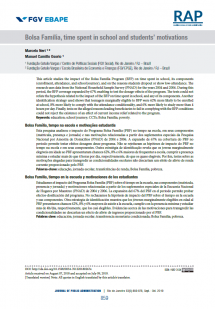
Bolsa Família, time spent in school and students’ motivations - Neri, Marcelo Cortes, Osorio, Manuel Camillo
Sobre o paper:
This article studies the impact of the Bolsa Família Program (BFP) on time spent in school, its components (enrollment, attendance, and school journey), and on the reasons students dropout or show low-attendance. The research uses data from the National Household Sample Survey (PNAD) for the years 2004 and 2006. During this period, the BFP coverage expanded by 67% enabling to test the dosage-effects of the program. The tests could not refute the hypothesis related to the impact of the BFP on time spent in school, and any of its components. Another identification strategy used shows that teenagers marginally eligible to BFP were 62% more likely to be enrolled at school, 8% more likely to comply with the attendance conditionality, and 6% more likely to study more than 4 hours per day. Finally, tests on the alleged reasons leading beneficiaries to fail in complying with the BFP conditions could not reject the existence of an effect of current income relief related to the program.
Keywords: education; school journey; CCTs; Bolsa Família; poverty.
REFERENCES
This paper was published in:
Academic Journal
NERI, Marcelo C; OSORIO, Manuel Camillo. Bolsa Família, time spent in school and students’ motivations. JOURNAL OF PUBLIC ADMINISTRATION. Edition 53(5). Pages 859-878. Spt.-Otc. 2019 - ISSN: 1982-3134 - Rio de Janeiro. Available online at: <http://bibliotecadigital.fgv.br/ojs/index.php/rap/article/view/80120>
Site
NERI, Marcelo C; OSORIO, Manuel Camillo. Bolsa Família, time spent in school and students’ motivations. FGV Social. Available online at: <https://cps.fgv.br/en/bolsa-familia-time-spent-school-and-students-motivations>




